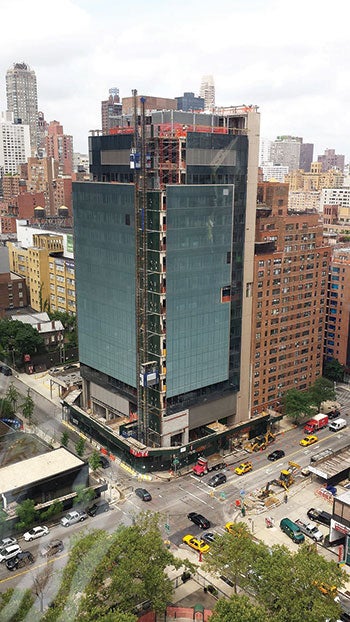New York leads wave of ambulatory care facility construction in large urban areas
 |
| PHOTO COURTESY OF MSK The Josie Robertson Surgery Center, under construction in New York City, will offer same day surgery and outpatient care. |
When Memorial Sloan Kettering Cancer Center (MSK), New York City, began plans to build a new cancer surgery center a few years ago in Manhattan, constructing a typical horizontally oriented ambulatory care facility was out of the question.
With vacant land at a premium, the only way to build was up, so up they went, says Suzen L. Heeley, executive director of design and construction at the cancer center. Problem solved.
Construction is well underway for the new vertical, $280 million, 176,000 sq. ft., 15-floor Josie Robertson Surgery Center that will offer minimally invasive and robot-assisted surgical technology in a patient- and family-friendly environment. The freestanding outpatient and short-stay cancer surgery center is scheduled for completion in January 2016.
While distinctive for its care and design, Josie Robertson is indicative of the rapid growth in ambulatory care facilities offering varying levels of clinical services in New York City and in large urban areas across the United States, Chicago among them.
According to John Wilson, president, HSA PrimeCare, a health care real estate developer in Chicago, the smaller new ambulatory facilities generally start at about 10,000 sq. ft. and may provide urgent care and primary care services at consumer-friendly locations. Multispecialty centers that provide primary care and urgent care offered by a wide range of specialists can range from 70,000 to 150,000 sq. ft. or more, he says.
Not surprisingly, New York City leads the United States in new ambulatory care space under construction or planned. An estimated 3.3 million sq. ft. to cost $2.2 billion are under construction or are in the late planning stages, according to Revista, a health care real estate data and analytics firm in Annapolis, Md. Of those projects, 75 percent will be built off campus.
There are many reasons for the growth, says Jeffrey Drucker, vice president, northeast region, Array Architects, New York City. The Affordable Care Act and changes in hospital reimbursements are critical factors for the wave of ambulatory care construction. Cost of health care delivery and patient convenience are important drivers, too, he says.
“People want same-day surgeries for more minor procedures or for procedures that years ago would have required an overnight stay or longer,” Drucker says.
The Josie Robertson Surgery Center is a case in point. “Today, only 10 percent of all MSK patients will ever have an inpatient encounter whereas, 20 years ago, care was provided predominantly on an inpatient basis,” Heeley says.
After opening three ambulatory sites over the last two years, MSK plans to open, expand or renovate five more sites in 2016 and 2017, she says.
Plus, in a competitive market, all health care systems are using new ambulatory care space to extend their brand outside the main campus, Drucker notes.
The Washington, D.C., area also is experiencing strong growth in ambulatory care facilities, with an estimated 1.9 million sq. ft. under construction or planned at a total cost of about $767 million, according to Revista. About 60 percent will be built off campus.
Since 2012, MedStar Health, Columbia, Md., has opened 10 urgent care centers and three multispecialty care centers that offer urgent care, physician offices, medical imaging, labs and physical rehabilitation. Over the next two years, MedStar will open four urgent care centers and five multispecialty centers.
The West Coast is seeing its share of new ambulatory care space too. Jason Krotts, principal, Real Estate Development Associates, Newport Beach, Calif., and Bryan McKenney, Cypress West Partners, Rancho Santa Margarita, Calif., are developing a new 64,000 sq. ft. medical office campus on vacant property near downtown Newport Beach.
“This is a unique opportunity. It’s not often you have a piece of land to work with close to the city center,” McKenney says.




